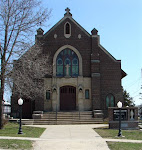He specialized in serious historical subjects, especially sombre and large-scale religious scenes, which seem out of place in a period renowned for its rather more amorous Rococo art and fetes galantes, although they demonstrate the continuity of the tradition of monumental figure painting throughout the 18th century. His son Jean-Bernard Restout is best known for his portraits.
Friday, October 22, 2010
Increasing the Beauty
As you walk into the vestibule of Sacred Heart Church this weekend you will notice that the bulletin board has been taken down. The items that were placed on the bulletin board are now on the tables behind the last pews . An art print titled “Pentecost” painted by Jean Restout II will replace the bulletin board. Some of you may be wondering "why the change?" Let us compare it to the decorating of your home. The entryway to a home should be warm, pleasing and inviting. The warmth of the colors of the art will help to do the same for the church. It will also connect the vestibule with the rest of the church's beauty. This is a way in which we can see the wisdom of the Church in use of beauty to lift up our mind and souls to God.
Below is a picture of the art print. Click on the image to in order to make it larger and see more detail..
Information about the artist:
Jean Restout II Painter and draughtsman, the most famous member of a family of painters, with an impressively active and successful career. His father, Jean Restout I was also painter. By 1707 he was in Paris as the pupil of his famous uncle, Jean Jouvenet, the leading religious painter in the capital. On 29 May 1717 Jean Restout II was approved (agr) by the Acadmie Royale and he was received (reu) on 28 June 1720, the year in which he married Marie-Anne Hall (b 1704), a daughter of the painter Claude-Guy Hall. Unlike most history painters of his time, Restout did not travel to Italy to study. He had a solid training with Jouvenet, and perhaps also with Nicolas de Largillierre,and, once established in the 1720s, he had a studio of assistants and pupils. He occasionally attended the drawing school of the Acadmie, where from 1730 he was professor of drawing, in which capacity he wrote his Essai sur les principes de la peinture.
He specialized in serious historical subjects, especially sombre and large-scale religious scenes, which seem out of place in a period renowned for its rather more amorous Rococo art and fetes galantes, although they demonstrate the continuity of the tradition of monumental figure painting throughout the 18th century. His son Jean-Bernard Restout is best known for his portraits.
To see this bio and more paintings by Jean Restout II click here: Art by Jean Restout II



